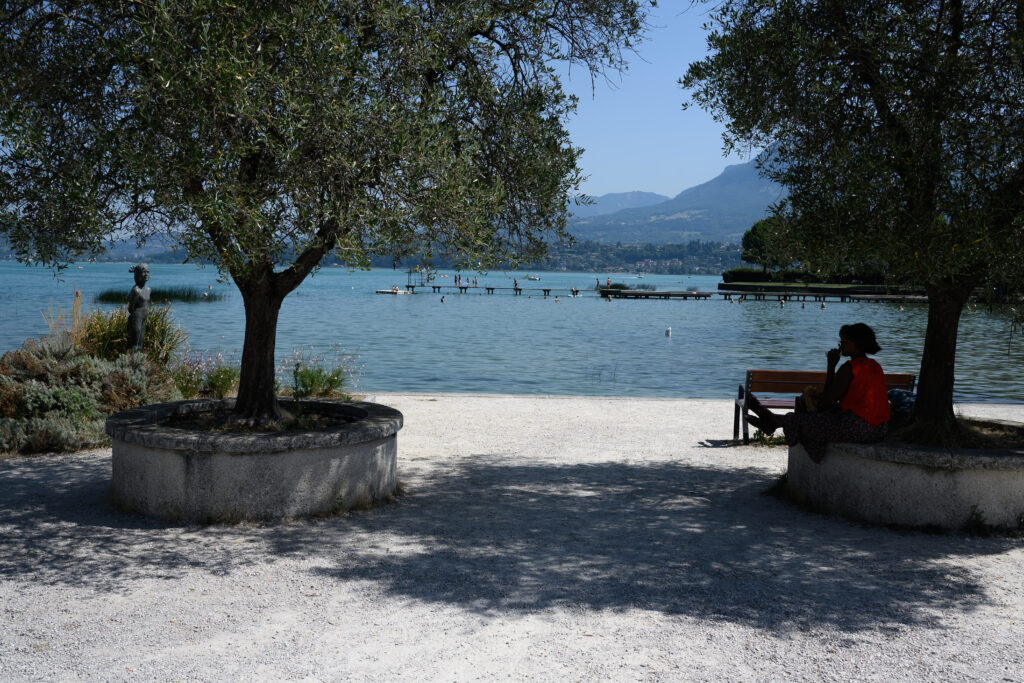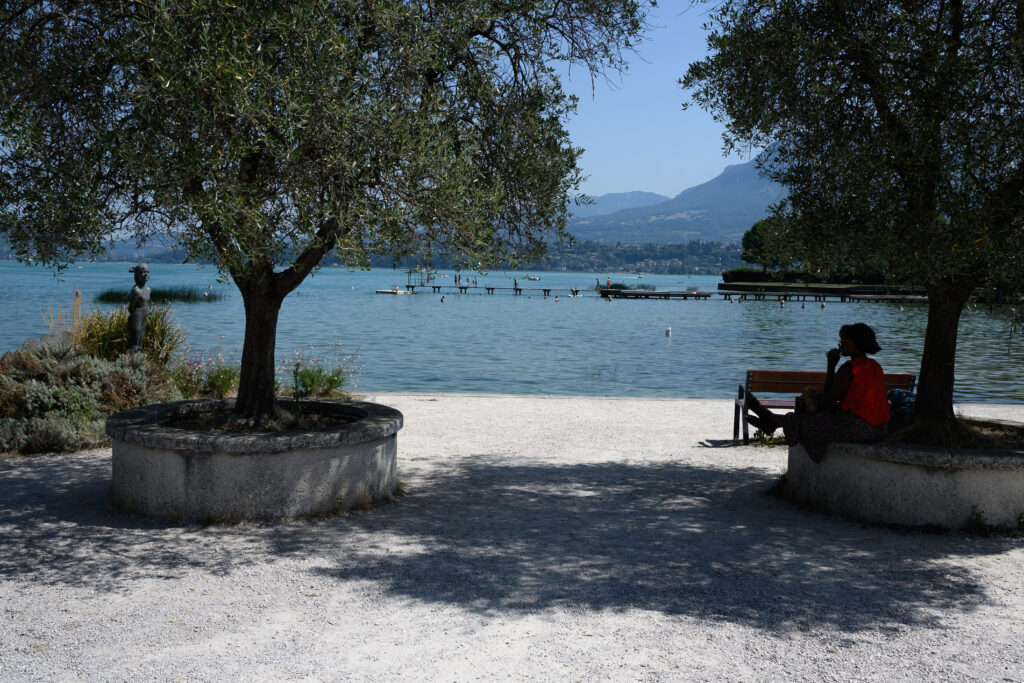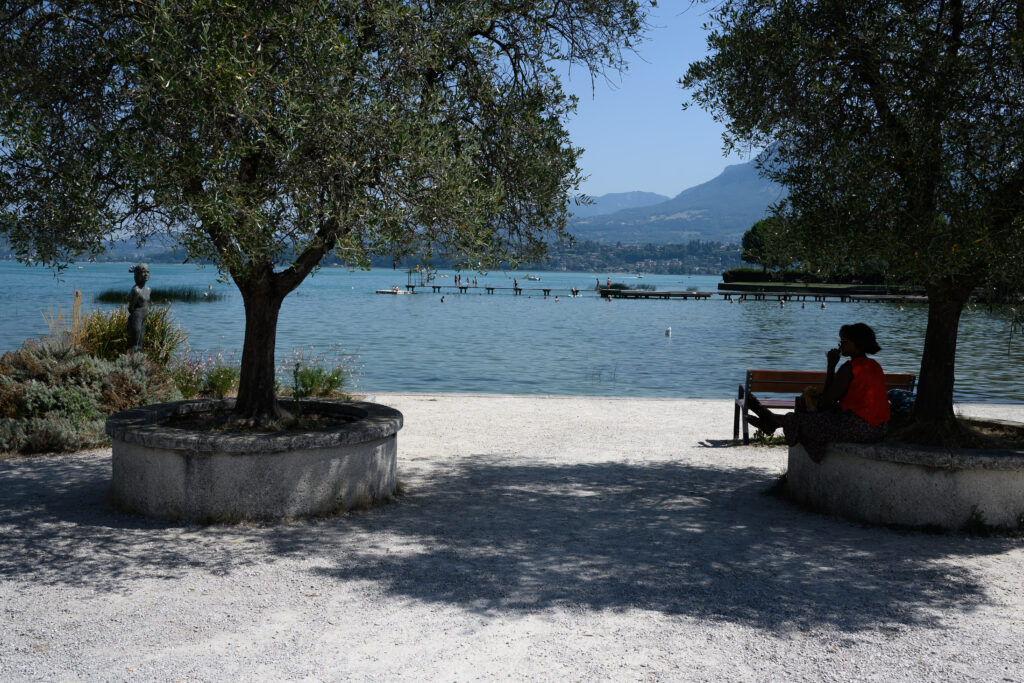La vague de chaleur se renforce sur le sud de la France
Le sud de la France suffoque samedi en proie à une vague de chaleur, la deuxième de cet été, et qui devrait se renforcer et s’étendre encore dimanche et au-delà.Une vaste partie sud du pays va subir ce weekend des températures comprises entre 34°C et 40°C, et qui pourront atteindre les 41°C du pied des Cévennes à la basse vallée du Rhône, selon Météo-France.Pour la journée de samedi, 28 départements du Sud se trouvent déjà en vigilance orange canicule, souligne Météo-France qui signale quelques températures “remarquables” relevées à 15H00: 38,0°C à Lyon-St-Exupéry, 36,8°C à Montélimar (Drôme) ou encore 35,8°C à Bordeaux-Mérignac.Dimanche, “la chaleur va encore monter d’un cran dans le Sud” et l’alerte sera étendue à la quasi-totalité de la moitié sud du pays, avec désormais 42 départements hors Corse en vigilance orange canicule, par ailleurs susceptible d’être encore étendue.Quant à la journée de lundi, elle se caractérisera par une “remontée d’une masse d’air extrêmement chaud sur une large partie du pays”, y compris au nord de la Loire, et sera sans doute “la plus chaude à l’échelle nationale”, a indiqué le prévisionniste.”Le pic est attendu entre lundi et mardi. (La vague de chaleur) devrait durer jusqu’en fin de semaine prochaine”, commente-t-il.- “Protégez-vous” -Dans ces circonstances, “protégez-vous”, insiste Météo-France, appelant chacun à rester au frais, privilégier “les activités douces et sans effort” ou encore “prendre des nouvelles de (ses) proches et des plus fragiles”.”On adapte notre rythme de vie, oui. On sort plus tôt, histoire de marcher un petit peu, et puis après on se renferme chez soi”, observe Eric Khellas, artiste-peintre rencontré par l’AFP sur les hauteurs de Lyon samedi.Pour se rafraîchir, les estivants sont aussi très nombreux au bord de l’eau ou en montagne, tandis que d’autres cherchent des alternatives, y compris sous terre. En Dordogne, où l’on attend des pics à 38°C samedi après-midi, la grotte de Villars, ornée de peintures préhistoriques vieilles de 20.000 ans, devrait ainsi faire le plein de visiteurs tout le weekend.”On a systématiquement des pics de visites quand il pleut, pour se mettre à l’abri, et quand il fait trop chaud, pour se rafraîchir. Habituellement c’est plus calme les samedis en août, mais là on part sur une grosse journée”, raconte l’un de ses gérants, Benoit Birckel, à l’accueil du site situé à 40 km au nord de Périgueux et dont les galeries affichent une température stable autour de 13°C, quelle que soit la saison.Mais pour Ophélie et Aurore, deux jeunes femmes dans la vingtaine qui n’ont pas souhaité donner leurs noms et travaillent dans un magasin d’alimentation du centre de Grenoble, la journée s’annonce “pénible” car “il fait souvent plus chaud dans le magasin que dehors”. Et pas de répit lorsqu’elles rentreront chez elles, leurs appartements étant “mal isolés”. – 1.240 km de bouchons -Après une première vague de chaleur du 19 juin au 4 juillet, cet épisode constitue la 51e vague de chaleur enregistrée en France depuis 1947. “On note une accélération de la survenue des vagues de chaleur au fil du temps. Cette tendance est bien liée au changement climatique, qui a un impact fort sur les températures en France hexagonale”, a déclaré à l’AFP Lauriane Batté, climatologue à Météo-France. L’épisode s’accompagne d’un danger “élevé” de feux de forêt sur le pourtour méditerranéen, alors que l’incendie qui a parcouru 16.000 hectares dans le massif des Corbières mobilise toujours 1.400 pompiers samedi ne pourra pas être sous contrôle avant dimanche en fin de journée, selon les pompiers.Il coïncide en outre avec un weekend de chassé-croisé entre vacanciers automobilistes. Un pic de 1.240 km de bouchons a été atteint peu avant midi, soit au-delà des niveaux déjà considérés comme “exceptionnels” par Bison Futé. La SNCF a de son côté indiqué avoir supprimé plusieurs allers-retours sur les lignes Bordeaux-Marseille et Paris-Clermont afin d'”anticiper des “pannes potentielles de climatisation liées aux très hautes températures” dans ses trains les plus anciens.
La vague de chaleur se renforce sur le sud de la France
Le sud de la France suffoque samedi en proie à une vague de chaleur, la deuxième de cet été, et qui devrait se renforcer et s’étendre encore dimanche et au-delà.Une vaste partie sud du pays va subir ce weekend des températures comprises entre 34°C et 40°C, et qui pourront atteindre les 41°C du pied des Cévennes à la basse vallée du Rhône, selon Météo-France.Pour la journée de samedi, 28 départements du Sud se trouvent déjà en vigilance orange canicule, souligne Météo-France qui signale quelques températures “remarquables” relevées à 15H00: 38,0°C à Lyon-St-Exupéry, 36,8°C à Montélimar (Drôme) ou encore 35,8°C à Bordeaux-Mérignac.Dimanche, “la chaleur va encore monter d’un cran dans le Sud” et l’alerte sera étendue à la quasi-totalité de la moitié sud du pays, avec désormais 42 départements hors Corse en vigilance orange canicule, par ailleurs susceptible d’être encore étendue.Quant à la journée de lundi, elle se caractérisera par une “remontée d’une masse d’air extrêmement chaud sur une large partie du pays”, y compris au nord de la Loire, et sera sans doute “la plus chaude à l’échelle nationale”, a indiqué le prévisionniste.”Le pic est attendu entre lundi et mardi. (La vague de chaleur) devrait durer jusqu’en fin de semaine prochaine”, commente-t-il.- “Protégez-vous” -Dans ces circonstances, “protégez-vous”, insiste Météo-France, appelant chacun à rester au frais, privilégier “les activités douces et sans effort” ou encore “prendre des nouvelles de (ses) proches et des plus fragiles”.”On adapte notre rythme de vie, oui. On sort plus tôt, histoire de marcher un petit peu, et puis après on se renferme chez soi”, observe Eric Khellas, artiste-peintre rencontré par l’AFP sur les hauteurs de Lyon samedi.Pour se rafraîchir, les estivants sont aussi très nombreux au bord de l’eau ou en montagne, tandis que d’autres cherchent des alternatives, y compris sous terre. En Dordogne, où l’on attend des pics à 38°C samedi après-midi, la grotte de Villars, ornée de peintures préhistoriques vieilles de 20.000 ans, devrait ainsi faire le plein de visiteurs tout le weekend.”On a systématiquement des pics de visites quand il pleut, pour se mettre à l’abri, et quand il fait trop chaud, pour se rafraîchir. Habituellement c’est plus calme les samedis en août, mais là on part sur une grosse journée”, raconte l’un de ses gérants, Benoit Birckel, à l’accueil du site situé à 40 km au nord de Périgueux et dont les galeries affichent une température stable autour de 13°C, quelle que soit la saison.Mais pour Ophélie et Aurore, deux jeunes femmes dans la vingtaine qui n’ont pas souhaité donner leurs noms et travaillent dans un magasin d’alimentation du centre de Grenoble, la journée s’annonce “pénible” car “il fait souvent plus chaud dans le magasin que dehors”. Et pas de répit lorsqu’elles rentreront chez elles, leurs appartements étant “mal isolés”. – 1.240 km de bouchons -Après une première vague de chaleur du 19 juin au 4 juillet, cet épisode constitue la 51e vague de chaleur enregistrée en France depuis 1947. “On note une accélération de la survenue des vagues de chaleur au fil du temps. Cette tendance est bien liée au changement climatique, qui a un impact fort sur les températures en France hexagonale”, a déclaré à l’AFP Lauriane Batté, climatologue à Météo-France. L’épisode s’accompagne d’un danger “élevé” de feux de forêt sur le pourtour méditerranéen, alors que l’incendie qui a parcouru 16.000 hectares dans le massif des Corbières mobilise toujours 1.400 pompiers samedi ne pourra pas être sous contrôle avant dimanche en fin de journée, selon les pompiers.Il coïncide en outre avec un weekend de chassé-croisé entre vacanciers automobilistes. Un pic de 1.240 km de bouchons a été atteint peu avant midi, soit au-delà des niveaux déjà considérés comme “exceptionnels” par Bison Futé. La SNCF a de son côté indiqué avoir supprimé plusieurs allers-retours sur les lignes Bordeaux-Marseille et Paris-Clermont afin d'”anticiper des “pannes potentielles de climatisation liées aux très hautes températures” dans ses trains les plus anciens.
La vague de chaleur se renforce sur le sud de la France
Le sud de la France suffoque samedi en proie à une vague de chaleur, la deuxième de cet été, et qui devrait se renforcer et s’étendre encore dimanche et au-delà.Une vaste partie sud du pays va subir ce weekend des températures comprises entre 34°C et 40°C, et qui pourront atteindre les 41°C du pied des Cévennes à la basse vallée du Rhône, selon Météo-France.Pour la journée de samedi, 28 départements du Sud se trouvent déjà en vigilance orange canicule, souligne Météo-France qui signale quelques températures “remarquables” relevées à 15H00: 38,0°C à Lyon-St-Exupéry, 36,8°C à Montélimar (Drôme) ou encore 35,8°C à Bordeaux-Mérignac.Dimanche, “la chaleur va encore monter d’un cran dans le Sud” et l’alerte sera étendue à la quasi-totalité de la moitié sud du pays, avec désormais 42 départements hors Corse en vigilance orange canicule, par ailleurs susceptible d’être encore étendue.Quant à la journée de lundi, elle se caractérisera par une “remontée d’une masse d’air extrêmement chaud sur une large partie du pays”, y compris au nord de la Loire, et sera sans doute “la plus chaude à l’échelle nationale”, a indiqué le prévisionniste.”Le pic est attendu entre lundi et mardi. (La vague de chaleur) devrait durer jusqu’en fin de semaine prochaine”, commente-t-il.- “Protégez-vous” -Dans ces circonstances, “protégez-vous”, insiste Météo-France, appelant chacun à rester au frais, privilégier “les activités douces et sans effort” ou encore “prendre des nouvelles de (ses) proches et des plus fragiles”.”On adapte notre rythme de vie, oui. On sort plus tôt, histoire de marcher un petit peu, et puis après on se renferme chez soi”, observe Eric Khellas, artiste-peintre rencontré par l’AFP sur les hauteurs de Lyon samedi.Pour se rafraîchir, les estivants sont aussi très nombreux au bord de l’eau ou en montagne, tandis que d’autres cherchent des alternatives, y compris sous terre. En Dordogne, où l’on attend des pics à 38°C samedi après-midi, la grotte de Villars, ornée de peintures préhistoriques vieilles de 20.000 ans, devrait ainsi faire le plein de visiteurs tout le weekend.”On a systématiquement des pics de visites quand il pleut, pour se mettre à l’abri, et quand il fait trop chaud, pour se rafraîchir. Habituellement c’est plus calme les samedis en août, mais là on part sur une grosse journée”, raconte l’un de ses gérants, Benoit Birckel, à l’accueil du site situé à 40 km au nord de Périgueux et dont les galeries affichent une température stable autour de 13°C, quelle que soit la saison.Mais pour Ophélie et Aurore, deux jeunes femmes dans la vingtaine qui n’ont pas souhaité donner leurs noms et travaillent dans un magasin d’alimentation du centre de Grenoble, la journée s’annonce “pénible” car “il fait souvent plus chaud dans le magasin que dehors”. Et pas de répit lorsqu’elles rentreront chez elles, leurs appartements étant “mal isolés”. – 1.240 km de bouchons -Après une première vague de chaleur du 19 juin au 4 juillet, cet épisode constitue la 51e vague de chaleur enregistrée en France depuis 1947. “On note une accélération de la survenue des vagues de chaleur au fil du temps. Cette tendance est bien liée au changement climatique, qui a un impact fort sur les températures en France hexagonale”, a déclaré à l’AFP Lauriane Batté, climatologue à Météo-France. L’épisode s’accompagne d’un danger “élevé” de feux de forêt sur le pourtour méditerranéen, alors que l’incendie qui a parcouru 16.000 hectares dans le massif des Corbières mobilise toujours 1.400 pompiers samedi ne pourra pas être sous contrôle avant dimanche en fin de journée, selon les pompiers.Il coïncide en outre avec un weekend de chassé-croisé entre vacanciers automobilistes. Un pic de 1.240 km de bouchons a été atteint peu avant midi, soit au-delà des niveaux déjà considérés comme “exceptionnels” par Bison Futé. La SNCF a de son côté indiqué avoir supprimé plusieurs allers-retours sur les lignes Bordeaux-Marseille et Paris-Clermont afin d'”anticiper des “pannes potentielles de climatisation liées aux très hautes températures” dans ses trains les plus anciens.
La vague de chaleur se renforce sur le sud de la France
Le sud de la France suffoque samedi en proie à une vague de chaleur, la deuxième de cet été, et qui devrait se renforcer et s’étendre encore dimanche et au-delà.Une vaste partie sud du pays va subir ce weekend des températures comprises entre 34°C et 40°C, et qui pourront atteindre les 41°C du pied des Cévennes à la basse vallée du Rhône, selon Météo-France.Pour la journée de samedi, 28 départements du Sud se trouvent déjà en vigilance orange canicule, souligne Météo-France qui signale quelques températures “remarquables” relevées à 15H00: 38,0°C à Lyon-St-Exupéry, 36,8°C à Montélimar (Drôme) ou encore 35,8°C à Bordeaux-Mérignac.Dimanche, “la chaleur va encore monter d’un cran dans le Sud” et l’alerte sera étendue à la quasi-totalité de la moitié sud du pays, avec désormais 42 départements hors Corse en vigilance orange canicule, par ailleurs susceptible d’être encore étendue.Quant à la journée de lundi, elle se caractérisera par une “remontée d’une masse d’air extrêmement chaud sur une large partie du pays”, y compris au nord de la Loire, et sera sans doute “la plus chaude à l’échelle nationale”, a indiqué le prévisionniste.”Le pic est attendu entre lundi et mardi. (La vague de chaleur) devrait durer jusqu’en fin de semaine prochaine”, commente-t-il.- “Protégez-vous” -Dans ces circonstances, “protégez-vous”, insiste Météo-France, appelant chacun à rester au frais, privilégier “les activités douces et sans effort” ou encore “prendre des nouvelles de (ses) proches et des plus fragiles”.”On adapte notre rythme de vie, oui. On sort plus tôt, histoire de marcher un petit peu, et puis après on se renferme chez soi”, observe Eric Khellas, artiste-peintre rencontré par l’AFP sur les hauteurs de Lyon samedi.Pour se rafraîchir, les estivants sont aussi très nombreux au bord de l’eau ou en montagne, tandis que d’autres cherchent des alternatives, y compris sous terre. En Dordogne, où l’on attend des pics à 38°C samedi après-midi, la grotte de Villars, ornée de peintures préhistoriques vieilles de 20.000 ans, devrait ainsi faire le plein de visiteurs tout le weekend.”On a systématiquement des pics de visites quand il pleut, pour se mettre à l’abri, et quand il fait trop chaud, pour se rafraîchir. Habituellement c’est plus calme les samedis en août, mais là on part sur une grosse journée”, raconte l’un de ses gérants, Benoit Birckel, à l’accueil du site situé à 40 km au nord de Périgueux et dont les galeries affichent une température stable autour de 13°C, quelle que soit la saison.Mais pour Ophélie et Aurore, deux jeunes femmes dans la vingtaine qui n’ont pas souhaité donner leurs noms et travaillent dans un magasin d’alimentation du centre de Grenoble, la journée s’annonce “pénible” car “il fait souvent plus chaud dans le magasin que dehors”. Et pas de répit lorsqu’elles rentreront chez elles, leurs appartements étant “mal isolés”. – 1.240 km de bouchons -Après une première vague de chaleur du 19 juin au 4 juillet, cet épisode constitue la 51e vague de chaleur enregistrée en France depuis 1947. “On note une accélération de la survenue des vagues de chaleur au fil du temps. Cette tendance est bien liée au changement climatique, qui a un impact fort sur les températures en France hexagonale”, a déclaré à l’AFP Lauriane Batté, climatologue à Météo-France. L’épisode s’accompagne d’un danger “élevé” de feux de forêt sur le pourtour méditerranéen, alors que l’incendie qui a parcouru 16.000 hectares dans le massif des Corbières mobilise toujours 1.400 pompiers samedi ne pourra pas être sous contrôle avant dimanche en fin de journée, selon les pompiers.Il coïncide en outre avec un weekend de chassé-croisé entre vacanciers automobilistes. Un pic de 1.240 km de bouchons a été atteint peu avant midi, soit au-delà des niveaux déjà considérés comme “exceptionnels” par Bison Futé. La SNCF a de son côté indiqué avoir supprimé plusieurs allers-retours sur les lignes Bordeaux-Marseille et Paris-Clermont afin d'”anticiper des “pannes potentielles de climatisation liées aux très hautes températures” dans ses trains les plus anciens.
Espagne : la mosquée-cathédrale de Cordoue rouvre après l’incendie
Les images ont fait craindre une catastrophe semblable à celle de Notre-Dame de Paris, mais la mosquée-cathédrale de Cordoue, dans le sud de l’Espagne, a rouvert ses portes au public samedi matin, quelques heures après un incendie provoquant des dégâts “très localisés” selon le maire de la ville.Le site, un joyau de l’architecture islamique classé au patrimoine mondial par l’Unesco, a ouvert à 10H00 (08H00 GMT) et fermera à 19h00, ses horaires habituels. Seule la zone où l’incendie s’est déclaré, connue sous le nom de nef d’Almanzor, restera inaccessible au public, a indiqué un porte-parole du site à l’AFP.”Il y a des dégâts, des dégâts importants, mais ils sont très, très localisés”, a précisé le maire de Cordoue, Jose Maria Bellido, à des journalistes à l’extérieur du bâtiment.La plupart des dégâts sont concentrés dans une chapelle où le feu s’est déclaré, dont le toit “s’est complètement effondré” sous l’effet des flammes et du poids de l’eau utilisée pour les éteindre, a-t-il ajouté dans une interview accordée à la télévision publique espagnole.Deux chapelles adjacentes ont subi des “dommages collatéraux”, principalement causés par la fumée, qui ont endommagé les retables et d’autres œuvres d’art, a déclaré le maire. Il a estimé que l’incendie n’avait endommagé que 50 à 60 mètres carrés du vaste intérieur du bâtiment, situé au centre de Cordoue, entouré des anciens quartiers juifs et mauresques.L’incendie spectaculaire s’est déclaré vendredi vers 21h00, suscitant des craintes pour l’édifice construit au début du Moyen Âge.Les pompiers sont restés sur place toute la nuit pour surveiller la zone incendiée après avoir éteint les flammes peu après minuit.Des vidéos massivement relayées sur les réseaux sociaux montraient des flammes et de la fumée s’échappant de l’intérieur de cette attraction touristique majeure, visitée par deux millions de personnes par an.Plusieurs véhicules de pompiers et de police étaient encore alignés dans une rue à proximité du bâtiment samedi matin, alors que des touristes faisaient la queue pour entrer, selon des images diffusées par des médias espagnols.- “Etincelle” -Les pompiers ont rapidement maîtrisé l’incendie, et le maire a affirmé aux médias espagnols que le monument avait été “sauvé”.Selon les premiers éléments de l’enquête, le feu s’est déclaré dans la chapelle centrale, située dans la zone dite d’Almanzor, avant de s’étendre à une partie de la couverture des voûtes, mais sans aller plus loin. La direction de la mosquée-cathédrale stockait dans cette chapelle, selon le maire, du matériel de nettoyage et du matériel audiovisuel, qui a peut-être été à l’origine du sinistre. “Il semble qu’il pourrait s’agir d’une batterie ou d’un contact électrique qui aurait produit une première étincelle”, a-t-il expliqué.Le quotidien ABC et d’autres médias ont rapporté qu’une balayeuse mécanique avait pris feu sur le site. Devenu depuis cathédrale, l’édifice a été initialement construit comme mosquée – sur l’emplacement d’une ancienne église – entre les VIIIe et Xe siècles par le dirigeant musulman de la ville, Abd ar-Rahman, un émir de la dynastie omeyyade.Après la reconquête de Cordoue, Murcie, Jaén et Séville par les chrétiens au XIIIe siècle sous le roi Ferdinand III de Castille, elle a été transformée en cathédrale et des modifications architecturales ont été apportées au fil des siècles suivants.L’Unesco a classé ce bâtiment au patrimoine mondial en 1984, le qualifiant d'”hybride architectural qui réunit de nombreuses valeurs artistiques orientales et occidentales et comprend des éléments jusqu’alors inconnus dans l’architecture religieuse islamique, notamment l’utilisation de doubles arches”.En 2001, un petit incendie avait déjà endommagé le monument, et notamment vingt-cinq documents anciens conservés dans la salle des archives des conseils de la cathédrale.
Espagne : la mosquée-cathédrale de Cordoue rouvre après l’incendie
Les images ont fait craindre une catastrophe semblable à celle de Notre-Dame de Paris, mais la mosquée-cathédrale de Cordoue, dans le sud de l’Espagne, a rouvert ses portes au public samedi matin, quelques heures après un incendie provoquant des dégâts “très localisés” selon le maire de la ville.Le site, un joyau de l’architecture islamique classé au patrimoine mondial par l’Unesco, a ouvert à 10H00 (08H00 GMT) et fermera à 19h00, ses horaires habituels. Seule la zone où l’incendie s’est déclaré, connue sous le nom de nef d’Almanzor, restera inaccessible au public, a indiqué un porte-parole du site à l’AFP.”Il y a des dégâts, des dégâts importants, mais ils sont très, très localisés”, a précisé le maire de Cordoue, Jose Maria Bellido, à des journalistes à l’extérieur du bâtiment.La plupart des dégâts sont concentrés dans une chapelle où le feu s’est déclaré, dont le toit “s’est complètement effondré” sous l’effet des flammes et du poids de l’eau utilisée pour les éteindre, a-t-il ajouté dans une interview accordée à la télévision publique espagnole.Deux chapelles adjacentes ont subi des “dommages collatéraux”, principalement causés par la fumée, qui ont endommagé les retables et d’autres œuvres d’art, a déclaré le maire. Il a estimé que l’incendie n’avait endommagé que 50 à 60 mètres carrés du vaste intérieur du bâtiment, situé au centre de Cordoue, entouré des anciens quartiers juifs et mauresques.L’incendie spectaculaire s’est déclaré vendredi vers 21h00, suscitant des craintes pour l’édifice construit au début du Moyen Âge.Les pompiers sont restés sur place toute la nuit pour surveiller la zone incendiée après avoir éteint les flammes peu après minuit.Des vidéos massivement relayées sur les réseaux sociaux montraient des flammes et de la fumée s’échappant de l’intérieur de cette attraction touristique majeure, visitée par deux millions de personnes par an.Plusieurs véhicules de pompiers et de police étaient encore alignés dans une rue à proximité du bâtiment samedi matin, alors que des touristes faisaient la queue pour entrer, selon des images diffusées par des médias espagnols.- “Etincelle” -Les pompiers ont rapidement maîtrisé l’incendie, et le maire a affirmé aux médias espagnols que le monument avait été “sauvé”.Selon les premiers éléments de l’enquête, le feu s’est déclaré dans la chapelle centrale, située dans la zone dite d’Almanzor, avant de s’étendre à une partie de la couverture des voûtes, mais sans aller plus loin. La direction de la mosquée-cathédrale stockait dans cette chapelle, selon le maire, du matériel de nettoyage et du matériel audiovisuel, qui a peut-être été à l’origine du sinistre. “Il semble qu’il pourrait s’agir d’une batterie ou d’un contact électrique qui aurait produit une première étincelle”, a-t-il expliqué.Le quotidien ABC et d’autres médias ont rapporté qu’une balayeuse mécanique avait pris feu sur le site. Devenu depuis cathédrale, l’édifice a été initialement construit comme mosquée – sur l’emplacement d’une ancienne église – entre les VIIIe et Xe siècles par le dirigeant musulman de la ville, Abd ar-Rahman, un émir de la dynastie omeyyade.Après la reconquête de Cordoue, Murcie, Jaén et Séville par les chrétiens au XIIIe siècle sous le roi Ferdinand III de Castille, elle a été transformée en cathédrale et des modifications architecturales ont été apportées au fil des siècles suivants.L’Unesco a classé ce bâtiment au patrimoine mondial en 1984, le qualifiant d'”hybride architectural qui réunit de nombreuses valeurs artistiques orientales et occidentales et comprend des éléments jusqu’alors inconnus dans l’architecture religieuse islamique, notamment l’utilisation de doubles arches”.En 2001, un petit incendie avait déjà endommagé le monument, et notamment vingt-cinq documents anciens conservés dans la salle des archives des conseils de la cathédrale.
Royaume-Uni: 200 arrestations lors d’une manifestation en soutien au groupe interdit Palestine Action
Un total de 200 partisans de l’organisation Palestine Action ont été arrêtés samedi lors d’une manifestation de soutien à Londres à ce réseau propalestinien, interdit depuis début juillet et classé comme “organisation terroriste”, a indiqué sur X la police londonienne.Cette interdiction a été jugée “disproportionnée” par l’ONU. “Nous avons désormais arrêté 200 personnes sur Parliament Square”, devant le Parlement britannique, a-t-elle écrit, expliquant avoir arrêté ou être “en train de le faire” à toutes les personnes ayant brandi la pancarte “Je m’oppose au génocide, je soutiens Palestine Action”.Sur place, des manifestants ont brandi d’autres pancartes comme “Agir contre le génocide n’est pas un crime” ou “Free Palestine”.”C’est un impératif moral d’être ici”, a déclaré à l’AFP Mathilda, qui ne souhaite pas donner son patronyme.La guerre dans la bande de Gaza a été déclenchée après l’attaque sans précédent du Hamas en Israël le 7 octobre 2023 qui a entraîné la mort de 1.219 personnes, en majorité des civils, selon un décompte de l’AFP réalisé à partir de données officielles israéliennes. Les représailles israéliennes ont depuis fait au moins 61.330 morts à Gaza, majoritairement des civils, selon les chiffres du ministère de la Santé du Hamas, jugés fiables par l’ONU.”S’ils veulent m’arrêter, je ne m’enfuirai pas et je ne me cacherai pas”, a ajouté cette septuagénaire venue spécialement de Bristol, à l’ouest de Londres, et qui était assise aux côtés d’autres manifestants avec la pancarte soutenant le groupe interdit.- “Rien à me reprocher” -“Qu’ils nous arrêtent tous”, a renchéri Richard Bull, un londonien de 42 ans dans un fauteuil roulant. “Ce gouvernement est allé trop loin. Je n’ai rien à me reprocher.” De nombreux drapeaux palestiniens étaient visibles dans la foule, à quelques pas de laquelle étaient alignés des voitures de police, a constaté une journaliste de l’AFP.La police avait mis en garde les participants contre les “potentielles conséquences pénales” de leurs actes.Les personnes arrêtées n’ont pas opposé de résistance, beaucoup formant un “V” de la victoire avec leurs doigts, sous les applaudissements d’autres manifestants, a constaté une journaliste de l’AFP.Palestine Action a été ajoutée début juillet à la liste des organisations considérées comme “terroristes” au Royaume-Uni, après des actes de vandalisme perpétrés par ses militants, notamment sur une base de l’armée de l’air.Le groupe Defend Our Juries organise depuis des manifestations pour protester contre cette interdiction.”Nous continuerons tant que le gouvernement tentera de faire taire ceux qui dénoncent sa complicité dans des crimes de guerre”, a réagi Defend Our Juries dans un communiqué.”Nous sommes déjà de plus en plus nombreux à nous préparer pour la prochaine vague d’actions en septembre.”- “Informations inquiétantes” -Le gouvernement britannique affirme que les sympathisants “ne connaissent pas la vraie nature” de Palestine Action. “Ce n’est pas une organisation non violente”, a assuré la ministre de l’Intérieur Yvette Cooper, disant disposer d'”informations inquiétantes” sur ses projets.Plus de 200 partisans avaient déjà été interpellées avant la manifestation de samedi, selon Tim Crosland, un représentant de Defend Our Juries. Trois personnes ont été inculpées en vertu de la loi antiterroriste jeudi pour avoir exprimé leur soutien au mouvement, une infraction passible de jusqu’à 6 mois de prison.L’appartenance à un groupe interdit ou l’incitation à le soutenir peut elle valoir jusqu’à 14 ans de prison. L’interdiction fait l’objet d’une action en justice, lancée par Huda Ammori, cofondatrice en 2020 de ce groupe qui se présentait comme un “réseau d’action directe” visant à dénoncer “la complicité britannique” avec l’État d’Israël, en particulier sur la question des ventes d’armes.
Royaume-Uni: 200 arrestations lors d’une manifestation en soutien au groupe interdit Palestine Action
Un total de 200 partisans de l’organisation Palestine Action ont été arrêtés samedi lors d’une manifestation de soutien à Londres à ce réseau propalestinien, interdit depuis début juillet et classé comme “organisation terroriste”, a indiqué sur X la police londonienne.Cette interdiction a été jugée “disproportionnée” par l’ONU. “Nous avons désormais arrêté 200 personnes sur Parliament Square”, devant le Parlement britannique, a-t-elle écrit, expliquant avoir arrêté ou être “en train de le faire” à toutes les personnes ayant brandi la pancarte “Je m’oppose au génocide, je soutiens Palestine Action”.Sur place, des manifestants ont brandi d’autres pancartes comme “Agir contre le génocide n’est pas un crime” ou “Free Palestine”.”C’est un impératif moral d’être ici”, a déclaré à l’AFP Mathilda, qui ne souhaite pas donner son patronyme.La guerre dans la bande de Gaza a été déclenchée après l’attaque sans précédent du Hamas en Israël le 7 octobre 2023 qui a entraîné la mort de 1.219 personnes, en majorité des civils, selon un décompte de l’AFP réalisé à partir de données officielles israéliennes. Les représailles israéliennes ont depuis fait au moins 61.330 morts à Gaza, majoritairement des civils, selon les chiffres du ministère de la Santé du Hamas, jugés fiables par l’ONU.”S’ils veulent m’arrêter, je ne m’enfuirai pas et je ne me cacherai pas”, a ajouté cette septuagénaire venue spécialement de Bristol, à l’ouest de Londres, et qui était assise aux côtés d’autres manifestants avec la pancarte soutenant le groupe interdit.- “Rien à me reprocher” -“Qu’ils nous arrêtent tous”, a renchéri Richard Bull, un londonien de 42 ans dans un fauteuil roulant. “Ce gouvernement est allé trop loin. Je n’ai rien à me reprocher.” De nombreux drapeaux palestiniens étaient visibles dans la foule, à quelques pas de laquelle étaient alignés des voitures de police, a constaté une journaliste de l’AFP.La police avait mis en garde les participants contre les “potentielles conséquences pénales” de leurs actes.Les personnes arrêtées n’ont pas opposé de résistance, beaucoup formant un “V” de la victoire avec leurs doigts, sous les applaudissements d’autres manifestants, a constaté une journaliste de l’AFP.Palestine Action a été ajoutée début juillet à la liste des organisations considérées comme “terroristes” au Royaume-Uni, après des actes de vandalisme perpétrés par ses militants, notamment sur une base de l’armée de l’air.Le groupe Defend Our Juries organise depuis des manifestations pour protester contre cette interdiction.”Nous continuerons tant que le gouvernement tentera de faire taire ceux qui dénoncent sa complicité dans des crimes de guerre”, a réagi Defend Our Juries dans un communiqué.”Nous sommes déjà de plus en plus nombreux à nous préparer pour la prochaine vague d’actions en septembre.”- “Informations inquiétantes” -Le gouvernement britannique affirme que les sympathisants “ne connaissent pas la vraie nature” de Palestine Action. “Ce n’est pas une organisation non violente”, a assuré la ministre de l’Intérieur Yvette Cooper, disant disposer d'”informations inquiétantes” sur ses projets.Plus de 200 partisans avaient déjà été interpellées avant la manifestation de samedi, selon Tim Crosland, un représentant de Defend Our Juries. Trois personnes ont été inculpées en vertu de la loi antiterroriste jeudi pour avoir exprimé leur soutien au mouvement, une infraction passible de jusqu’à 6 mois de prison.L’appartenance à un groupe interdit ou l’incitation à le soutenir peut elle valoir jusqu’à 14 ans de prison. L’interdiction fait l’objet d’une action en justice, lancée par Huda Ammori, cofondatrice en 2020 de ce groupe qui se présentait comme un “réseau d’action directe” visant à dénoncer “la complicité britannique” avec l’État d’Israël, en particulier sur la question des ventes d’armes.







